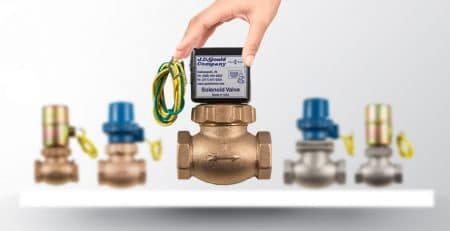Piston-pilot Operated Solenoid Valves are a great solution to control the flow of fluids, steam, and gases on a wide variety of temperature ranges, as well as the availability of AC and DC voltages. Piston-pilot Operated Solenoid Valves use a two-step process to operate:
- Normally closed valves stay in the closed position until electricity is sent to the solenoid coil. The coil creates an electro-magnet and the Pilot is magnetic.
Step 1 of the opening process involves the Pilot lifting off of the Piston exposing a main orifice in the center of the piston. - Step 2, the fluid above the Piston is released through the main orifice and the inlet pressure coupled with the piston ring forces the valve open. All of this is accomplished in milliseconds. For Normally Open Solenoid Valves, the operation is simply reversed.
Industrial applications of Solenoid Valves allow the user to remotely control flow. This can be simply done by using a level switch on a fill tank or a control room in a plant that could have numerous Solenoid Valves which are computer-controlled. A wall in the control room could indicate which valves are “on” with a green light and those that are “off” with a red light. No matter how sophisticated your system, it may well require the simplicity of Solenoid Valves turning on and off on command.
Easy Installation
Solenoid Valves are known for their ease of installation. Like other products involving dual specifications (electrical and fluid/pressure), Solenoid Valves must be properly chosen. Professional plumbers and electricians are ideal for installing the valves. Make sure the information on the valve’s nameplate agrees with your application. Also, be sure to read all instructional material that is packaged with the valve. Should you have any questions, be sure to consult a factory expert.
Voltage
Solenoid Valves come in many different voltage options:
- 6V DC · 12V DC · 24V DC · 48V DC · 115V DC · 230V DC
- 24V AC · 120V AC · 240V AC · 480V AC · 12V AC AC = 50Hz or 60Hz
- 120-240/60Hz Dual Voltage Coil – allows wiring to either voltage
Coils are also available in different types of insulations based on temperature ratings. The insulation classes are:
- Class A: 220°F Maximum Fluid Temp @ 77°F Ambient
- Class B: 300°F Maximum Fluid Temp @ 77°F Ambient
- Class F: 356°F Maximum Fluid Temp @ 77°F Ambient
- Class H: 365°F Maximum Fluid Temp @ 77°F Ambient
- Class N: 392°F Maximum Fluid Temp @ 77°F Ambient
Coils can also be wound for rarer voltages to suit the application. The valve can still operate at lower voltages than normal. This is the best solution for units that are powered by batteries.
Gould Solenoid Valves AC & DC coils are rated as continuous duty. System designers need to take into account the extra heat since it can impact the fluid temperatures, energization frequency, and the coil’s life expectancy. Most coils (solenoids) have two simple lead wires and can also have a green ground wire. Either of the two wires can be line voltage.
Special Coil Enclosures
Most Solenoid Valve applications use a standard NEMA 1 coil enclosure. However, there are several specialized enclosures listed below:
- NEMA Type 4 Electrical Enclosure: Commonly known as a Watertight Enclosure
- NEMA Type 4X Electrical Enclosure: Commonly known as an Ice & Splash Resistant Enclosure
- NEMA Type 5 Electrical Enclosure: Commonly known as a Dust-tight Enclosure
- NEMA Type 6 Electrical Enclosure: For Temporary Submersion
- NEMA Type 6P Electrical Enclosure: For Occasional Prolonged Submersion
- NEMA Type 7 Electrical Enclosure: Explosion-proof Housing
For an industrial application of Solenoid Valves that involve explosive atmospheres, NEMA 7 Explosion-proof coil enclosures must be specified. These valves are installed in a volatile, gaseous atmosphere. Any possibility of an electrical short would be contained within the NEMA 7 enclosure, thus “housing” the explosion. Another feature used by Solenoid Valve manufacturers is known as Intrinsically Safe valves. The coils on these valves keep power outputs so low that they are unable to ignite any volatile gases in the environment.
Speed
The time for opening and closing Solenoid Valves is often timed around 50-800 milliseconds. The smaller the valve, the quicker the internal components move to open or close it. The greater the viscosity of the liquid flowing through the valve, the longer it will take for the valve to operate. Nevertheless, Solenoid Valves work really fast especially in comparison to motorized ball valves. In some situations, the speed of Solenoid Valves can be detrimental. The result of a large valve closing fast can result in Water Hammer. Gould Solenoid Valves feature known as Velvetrol® helps to eliminate Water Hammer. You should also be able to order a slow-close feature for your valve to counter-act the closing speed. Don’t forget a basic principle: the faster a valve opens, the slower it will close.
Packless
One last desirable feature of Solenoid Valves is that they are packless. The openings on packless Solenoid Valves are limited to three places: the Inlet, Outlet and Bonnet (top). Solder joints or welds are used instead of “O” rings or flared tubing.
Summary
As you can see, the industrial application of solenoid valves is vast, since they are versatile additions to any plant or job site. They can be easily worked on after installation. Solenoid Valves are designed for the most simple On/Off applications, all the way up to managing a spray-down system at a 1,000 acre hog farm from 100 miles away via satellite.














Leave a Reply